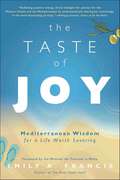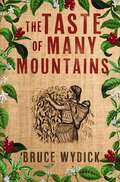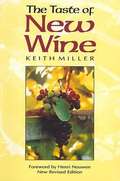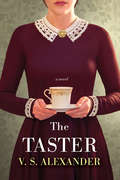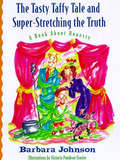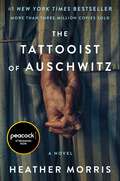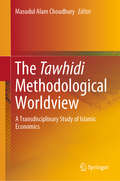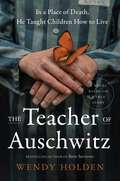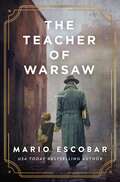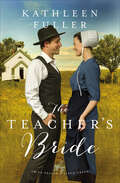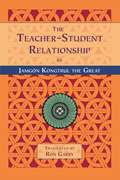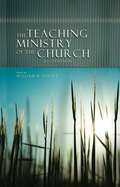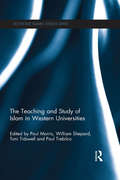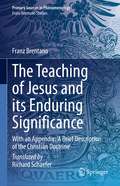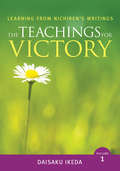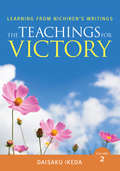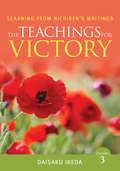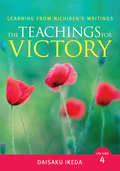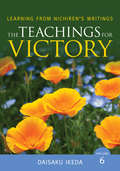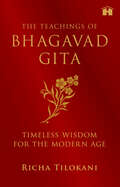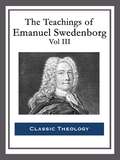- Table View
- List View
The Taste of Joy: Mediterranean Wisdom for a Life Worth Savoring
by Emily A. FrancisEmbrace the Wisdom of the Mediterranean to Create a Delicious LifeAfter moving to Malta with her family during the 2020 pandemic, Emily A. Francis learned insider secrets to one of the healthiest lifestyles in the world. Now she shares these insights so that you too can improve your wellness and invigorate your spirit.The Taste of Joy shows you the importance of living simply, mindfully, and naturally while nourishing your body and soul. Discover your own path to happiness as Emily recounts eye-opening experiences with a country and culture that made her come alive. Using food as a metaphor for life, this book highlights local methods for harvesting and cooking while exploring Mediterranean values. With Emily's pearls of wisdom and a handful of recipes, you can get a taste of bliss and create a life you can relish instead of simply endure.
The Taste of Many Mountains
by Bruce WydickThe global coffee trade is a collision between the rich world and the poor world.A group of graduate students is about to experience that collision head-on.Angela, Alex, Rich, and Sofi a bring to their summer research project in Guatemala more than their share of grad-school baggage--along with clashing ideas about poverty and globalization. But as they follow the trail of coffee beans from the Guatemalan peasant grower to the American coffee drinker, what unfolds is not only a stunning research discovery, but an unforgettable journey of personal challenge and growth.Based on an actual research project on fair trade coffee funded by USAID, The Taste of Many Mountains is a brilliantly-staged novel about the global economy in which University of San Francisco economist Bruce Wydick examines the realities of the coffee trade from the perspective of young researchers struggling to understand the chasm between the world's rich and poor."Wydick's first novel is brewed perfectly--full of rich body with double-shots of insight." --Santiago "Jimmy" Mellado, President and CEO of Compassion International"This wonderfully enlightening book describes the Mayan culture in Guatemala and some of the sufferings these people have survived." --CBA Retailers + ResourcesIncludes Reading Group Guide
The Taste of New Wine
by Keith MillerKeith Miller shares the spiritual journey of his heart, a pilgrimage which has enabled him to follow God's will on a daily basis, deepen his prayer life, bring God into the office, and to share his faith in more dynamic ways.
The Taster: A Novel
by V. S. AlexanderAmid the turbulence of World War II, a young German woman finds a precarious haven closer to the source of danger than she ever imagined—one that will propel her through the extremes of privilege and terror under Hitler’s dictatorship . . . In early 1943, Magda Ritter’s parents send her to relatives in Bavaria, hoping to keep her safe from the Allied bombs strafing Berlin. Young German women are expected to do their duty—working for the Reich or marrying to produce strong, healthy children. After an interview with the civil service, Magda is assigned to the Berghof, Hitler’s mountain retreat. Only after weeks of training does she learn her assignment: she will be one of several young women tasting the Führer’s food, offering herself in sacrifice to keep him from being poisoned. Perched high in the Bavarian Alps, the Berghof seems worlds away from the realities of battle. Though terrified at first, Magda gradually becomes used to her dangerous occupation—though she knows better than to voice her misgivings about the war. But her love for a conspirator within the SS, and her growing awareness of the Reich’s atrocities, draw Magda into a plot that will test her wits and loyalty in a quest for safety, freedom, and ultimately, vengeance. Vividly written and ambitious in scope, The Taster examines the harrowing moral dilemmas of war in an emotional story filled with acts of extraordinary courage. Praise for V.S. Alexander’s The Magdalen Girls “Fans of Barbara Davis and Ashley Hay will enjoy this tenderhearted story of sinner, saints, and redemption.” --Booklist “Alexander has clearly done his homework. Chilling in its realism, his work depicts the improprieties long abandoned by the Catholic Church and only recently acknowledged. Fans of the book and film Philomena will want to read this.” --Library Journal
The Tasty Taffy Tale and Super-Stretching the Truth
by Barbara JohnsonWhen Michael stretches the truth about how he won the taffy-making contest, the Geranium Lady helps him understand that saying things that are not true is like mixing bad ingredients into a recipe.
The Tattooist of Auschwitz: A Novel
by Heather MorrisThe #1 International Bestseller & New York Times BestsellerThis beautiful, illuminating tale of hope and courage is based on interviews that were conducted with Holocaust survivor and Auschwitz-Birkenau tattooist Ludwig (Lale) Sokolov—an unforgettable love story in the midst of atrocity.“The Tattooist of Auschwitz is an extraordinary document, a story about the extremes of human behavior existing side by side: calculated brutality alongside impulsive and selfless acts of love. I find it hard to imagine anyone who would not be drawn in, confronted and moved. I would recommend it unreservedly to anyone, whether they’d read a hundred Holocaust stories or none.”—Graeme Simsion, internationally-bestselling author of The Rosie ProjectIn April 1942, Lale Sokolov, a Slovakian Jew, is forcibly transported to the concentration camps at Auschwitz-Birkenau. When his captors discover that he speaks several languages, he is put to work as a Tätowierer (the German word for tattooist), tasked with permanently marking his fellow prisoners.Imprisoned for over two and a half years, Lale witnesses horrific atrocities and barbarism—but also incredible acts of bravery and compassion. Risking his own life, he uses his privileged position to exchange jewels and money from murdered Jews for food to keep his fellow prisoners alive.One day in July 1942, Lale, prisoner 32407, comforts a trembling young woman waiting in line to have the number 34902 tattooed onto her arm. Her name is Gita, and in that first encounter, Lale vows to somehow survive the camp and marry her.A vivid, harrowing, and ultimately hopeful re-creation of Lale Sokolov's experiences as the man who tattooed the arms of thousands of prisoners with what would become one of the most potent symbols of the Holocaust, The Tattooist of Auschwitz is also a testament to the endurance of love and humanity under the darkest possible conditions.
The Tawhidi Methodological Worldview: A Transdisciplinary Study of Islamic Economics
by Masudul Alam ChoudhuryThis book develops and applies the methodology of Tawhid (“monotheism”) as law and the Sunnah (the teachings of Prophet Muhammad) in the Qur’an in establishing a transdisciplinary foundation for the study of Islamic economics, finance, society, and science. It employs the Tawhidi String Relation (TSR), a new theoretical framework in contemporary Islamic sciences, in the methodological formalisation and application of the Tawhidi worldview - as the primal ontological law of monotheism. It employs a deeply Qur’anic exegesis, and a mathematical, philosophical, and socio-scientific mode of inquiry in deriving, developing, and empirically applying the Qur’anic methodology of “unity of knowledge”. It is the first book of its kind in rigorously studying the true foundation of the Qur’anic concept of ‘everything’ - as the world-system extending between the heavens and Earth. The qur’anic terminology of the precept of this “world-system” in its most comprehensive perspective is A’lameen, the terminology in the Qur’an that accounts for the generality and details of the world-systems that are governed by the method of evaluation of the objective criterion of wellbeing. Wellbeing objective criterion is evaluated subject to inter-causal relations between systemic entities, variables, and functions. The cardinal principle of Tawhid in its relationship with the world-system conveys the corporeal meaning of monotheism in its cognitive implication of abstraction and application. Such a study has not been undertaken in existing Islamic socio-scientific literature in analysing Islamic economics, finance, science, and society collectively, using Tawhidi law as a theoretical framework. This book will be relevant to all such scholars who are interested in studying the monotheistic law and the Islamic principles, particularly Tawhid, Shari’ah, and Islamic philosophical thought.
The Tea Will Tell (Tearoom Mysteries #11)
by Elizabeth LudwigIn the height of Lake Chickadee's tourist season, a spate of home invasion burglaries begins making front-page news. Jan and Elaine discover that someone has left a gun behind in the tearoom. The gun appears to be the same one the newspaper reported as used in the break-ins. But why would someone leave that weapon behind, yet not try to rob the place? Or did they? Worried that their neighborhood is being threatened by a dangerous thief, the cousins set out to find the villain. What they discover goes far beyond anything they imagined! Meanwhile, Jan struggles to say good-bye to Bob, and Archie continues his pursuit to learn more about the beautiful but mysterious painting that the cousins found at the flea market. Mix together one stately Victorian home, a charming lakeside town in Maine, and two adventurous cousins with a passion for tea and hospitality. Add a large scoop of intriguing mystery and sprinkle generously with faith, family, and friends, and you have the recipe for Tearoom Mysteries.
The Teacher of Auschwitz: A Novel
by Wendy HoldenFrom the bestselling author of Born Survivors, a novel inspired by the powerful true story of a man who risked everything to protect children in Auschwitz.Fredy built a wall against suffering in their hearts . . .Amid the brutality of the Holocaust, one bright spot shone inside the Nazi death camp of Auschwitz. In the shadows of the smokestacks was a wooden hut where children sang, staged plays, wrote poetry, and learned about the world. Within those four walls, brightly adorned with hand-painted cartoons, the youngest prisoners were kept vermin-free, received better food, and were even taught to imagine having full stomachs and a day without fear. Their guiding light was a twenty-seven-year-old gay, Jewish athlete: Fredy Hirsch.Being a teacher in a brutal concentration camp was no mean feat. Forced to beg senior SS officers for better provisions, Fredy risked his life every day to protect his beloved children from mortal danger.But time was running out for Fredy and the hundreds in his care. Could this kind, compassionate, and brave man find a way to teach them the one lesson they really needed to know: how to survive?The Teacher of Auschwitz shines a light on a truly remarkable individual and tells the inspiring story of how he fought to protect innocence and hope amid depravity and despair.
The Teacher of Warsaw
by Mario EscobarFor fans of The Warsaw Orphan and The Tattooist of Auschwitz: the start of WWII changed everything in Poland irrevocably—except for one man&’s capacity to love.September 1, 1939. Sixty-year-old Janusz Korczak and the students and teachers at his Dom Sierot Jewish orphanage are outside enjoying a beautiful day in Warsaw. Hours later, their lives are altered forever when the Nazis invade. Suddenly treated as an outcast in his own city, Janusz—a respected leader known for his heroism and teaching—is determined to do whatever it takes to protect the children from the horrors to come.When over four hundred thousand Jewish people are rounded up and forced to live in the 1.3-square-mile walled compound of the Warsaw ghetto, Janusz and his friends take drastic measures to shield the children from disease and starvation. With dignity and courage, the teachers and students of Dom Sierot create their own tiny army of love and bravely prepare to march toward the future—whatever it may hold.Unforgettable, devastating, and inspired by a real-life hero of the Holocaust, The Teacher of Warsaw reminds the world that one single person can incite meaning, hope, and love.Praise for The Teacher of Warsaw:&“Through meticulous research and with wisdom and care, Mario Escobar brings to life a heartbreaking story of love and extraordinary courage. I want everyone I know to read this book.&” —Kelly Rimmer, New York Times bestselling author of The Warsaw Orphan&“A beautifully written, deeply emotional story of hope, love, and courage in the face of unspeakable horrors. That such self-sacrifice, dedication and goodness existed restores faith in humankind. Escobar's heart-rending yet uplifting tale is made all the more poignant by its authenticity. Bravo!&” —Tea Cooper, award-winning and bestselling author of The Cartographer&’s SecretWorld War II historical fiction inspired by true eventsIncludes discussion questions for book clubs, a historical timeline, and notes from the authorBook length: 83,000 wordsAlso by author: Auschwitz Lullaby, Children of the Stars, Remember Me, The Librarian of Saint-Malo
The Teacher's Bride: The Teacher's Bride, The Farmer's Bride, The Innkeeper's Bride (Amish Brides of Birch Creek #1)
by Kathleen FullerA fun and heartwarming Amish rom-com where opposites really do attract. If there is one thing Christian Ropp will not allow in his classroom—or his life—it&’s chaos. So why is he drawn to Ruby Glick, a woman who seems to bring mayhem wherever she goes?Christian Ropp moves to Birch Creek to accept a teaching position in the rapidly growing Amish community. He&’s determined to put the rambunctious school in order as well as check another task off his list: finding a wife. Of course, that would be much easier if women were like textbooks, straightforward and logical.When an accident puts Christian out of commission, a new community member named Ruby Glick takes over his classroom. But Ruby&’s exuberant teaching style clashes with Christian's careful methods and he worries his students will never be the same.With a track record of catastrophe, Ruby always feels too clumsy, too distracted, too . . . much. Desperate for a chance to prove that she can do more than make mistakes in her life, she throws herself into her new teaching position. But when Christian can&’t seem to stay out of her way, she finds herself slipping into old, chaotic tendencies.What she doesn&’t anticipate is that Christian's heart is slowly catching up with his mind—and she, too, must decide whether to follow logic or love. The first in the Amish Brides of Birch Creek series (followed by The Farmer&’s Bride and The Innkeeper&’s Bride)A full-length novel, approximately 78,000 wordsA sweet and wholesome Amish romanceCatch up on the Birch Creek community with the Amish of Birch Creek series and Amish Letters series Praise for The Teacher&’s Bride:"A heartwarming story of unexpected romance woven with fun and engaging characters who come to life on every page." --Amy Clipston, bestselling author of A Seat by the Hearth "Kathleen Fuller has written a sweet, oftentimes humorous, romance that reminds readers that the perfect match might be right in front of their noses." --Kelly Irvin, bestselling author of the Every Amish Season series"Kathleen Fuller is a master storyteller and fans will absolutely fall in love with Ruby and Christian in The Teacher's Bride." --Ruth Reid, bestselling author of the Amish Mercies series"Kathy Fuller's characters leap off the page with subtle power as she uses both wit and wisdom to entertain!" --Kelly Long, national bestselling author"The story will captivate you from the first page to the last with Ruby, Christian, and engaging characters. You&’ll laugh, gasp, and wonder what will happen next." --Molly Jebber, Speaker and Award Winning Author of Grace&’s Forgiveness and the Amish Keepsake Pocket Quilt Series
The Teacher's Christmas Secret: An Uplifting Inspirational Romance (Seven Amish Sisters #3)
by Emma MillerThe Amish school brings them together Will his secret break them apart? When widowed schoolteacher Tobit Lapp is injured, he reluctantly agrees he needs Cora Koffman&’s help. Cora&’s still upset Tobit got the job at the Amish schoolhouse, but she agrees to teach his class till he&’s able. As they work together on lessons, a surprising friendship blossoms between them, but Tobit&’s heart is torn. He&’s falling for Cora—yet his secret could ruin everything…From Love Inspired: Uplifting stories of faith, forgiveness and hope.Seven Amish Sisters Book 1: Her Surprise Christmas CourtshipBook 2: Falling for the Amish Bad BoyBook 3: The Teacher's Christmas Secret
The Teacher-Student Relationship
by Jamgon Kongtrul Ron GarryIt is crucial for students of Vajrayana Buddhism to find an authentic wisdom teacher and know how to properly rely upon that teacher in order to awaken to their buddha nature and thereby attain full enlightenment. Fortunately, the topic has been thoroughly explored by Jamgon Kongtrul in the tenth chapter of The Treasury of Knowledge. This essential text clearly lays out what credentials and qualities one should look for in a wisdom teacher, why a wisdom teacher is necessary, and how the relationship between this teacher and disciple best develops once it is established.
The Teaching Ministry of the Church (Second Edition)
by William YountThe second edition of The Teaching Ministry of the Church makes a major overhaul of its predecessor, increasing the content from eighteen to twenty three chapters and contributors from six to thirteen. These writers assert the need for such an expanded update is due to our everchanging world. For example, the rise of Islamic fundamentalism, proliferation of religious sects, and secularization of our culture greatly increase the importance of ensuring the church produces fully developed, biblically informed followers of Jesus. To that end, The Teaching Ministry of the Church presents a full overview of Christian education in four major sections: Theological Foundations, Biblical Foundations, Preparation for Teaching, and Structuring the Teaching Ministry of the Church. Within this framework, a step-by-step plan for establishing and maintaining an effective teaching ministry among preschoolers, children, youth, and adults takes shape. Key chapters: "The Bible as Curriculum," "The Church's Role in Teaching," "Creating an Unforgettable Learning Experience," and "Equipping Teachers. "
The Teaching and Study of Islam in Western Universities (Routledge Islamic Studies Series)
by Paul Trebilco Paul Morris William Shepard Toni TidswellPublic interest in the religion of Islam and in Muslim communities in recent years has generated an impetus for Western Universities to establish an array of Institutes and programs dedicated to the study of Islam. Despite the growth in number of programs dedicated to this study, very little attention has been paid to the appropriate shape of such programs and the assumptions that ought to underlie such a study. The Teaching and Study of Islam in Western Universities attempts to address two central questions that arise through the teaching of Islam. Firstly, what relation is there between the study of the religion of Islam and the study of those cultures that have been shaped by that religion? Secondly, what is the appropriate public role of a scholar of Islam? After extensive discussion of these questions, the authors then continue to address the wider issues raised for the academic community having to negotiate between competing cultural and philosophical demands. This edited collection provides new perspectives on the study of Islam in Western Institutions and will be an invaluable resource for students of Education and Religion, in particular Islamic Studies.
The Teaching of Jesus and its Enduring Significance: With an Appendix: 'A Brief Description of the Christian Doctrine' (Primary Sources in Phenomenology)
by Franz BrentanoHere, for the first time in English, is Franz Brentano’s The Teaching of Jesus, a compendium of texts Brentano assembled for publication shortly before his death that constitute a frank, public settling of accounts with the Christian religion. Originally conceived by Brentano as a volume that might help others similarly led to doubt the doctrines of Christianity, the book is remarkably free of bitterness or spitefulness. On the contrary, what makes the book of singular importance, especially now, is its careful attempt at taking stock of the positive and negative influence Christianity has had in history. This text appeals to those researchers and scholars interested in the work of Franz Brentano and his work on the philosophy of religion, in this case, Christianity.
The Teachings for Victory, Volume 1 (Learning from Nichiren's Writings)
by Daisaku IkedaWhat constitutes a meaningful life? What is true happiness? Nichiren Buddhism, based on the Lotus Sutra, is a teaching of hope that provides answers to these and other important questions for modern life. Ranked among the most important works in Mahayana Buddhism, Nichiren’s 13th century writings were revolutionary. They provide a practical formula for enabling everyone to achieve a victory in every aspect of their lives and attain an unshakable state of happiness.
The Teachings for Victory, Volume 2 (Learning from Nichiren's Writings)
by Daisaku IkedaNichiren Daishonin’s writings provide a practical formula for enabling all people to achieve victory in every aspect of their lives and attain an unshakable state of happiness. This volume of Learning from Nichiren’s Writings: The Teachings for Victory contains SGI President Daisaku Ikeda’s lectures on seven of Nichiren’s letters: "On Practicing the Buddha’s Teachings"; "The Proof of the Lotus Sutra"; "The Hero of the World"; "The Blessings of the Lotus Sutra"; "The Sutra of True Requital"; "King Rinda"; and "The Kalpa of Decrease."
The Teachings for Victory, Volume 3 (Learning from Nichiren's Writings)
by Daisaku IkedaNichiren Daishonin’s writings provide a practical formula for enabling all people to achieve victory in every aspect of their lives and attain an unshakable state of happiness. This volume of Learning from Nichiren’s Writings: The Teachings for Victory contains SGI President Daisaku Ikeda’s lectures on nine of Nichiren’s letters: “On the Offering of a Mud Pie” “A Father Takes Faith” “How Those Initially Aspiring to the Way Can Attain Buddhahood through the Lotus Sutra” “Letter to the Lay Priest Nakaoki” “Letter to Konichi-bo” “The Good Medicine for All Ills” “The Four Debts of Gratitude” “On the Treasure Tower” “Letter from Teradomari” President Ikeda elucidates the importance of studying Nichiren’s writings as the foundation of Nichiren Buddhism as practiced by the Soka Gakkai International. His lectures bring Nichiren’s immense wisdom, compassion, and courage into focus for the present age. In reading and studying these lectures, we learn how to apply in daily life Nichiren’s profound philosophy for inner transformation and victory for both ourselves and others. The Teachings for Victory will empower you to develop the strength and wisdom to bring forth your inherent potential.
The Teachings for Victory, Volume 4 (Learning from Nichiren's Writings)
by Daisaku IkedaNichiren Daishonin’s writings provide a practical formula for enabling all people to achieve victory in every aspect of their lives and attain an unshakable state of happiness. This volume of Learning from Nichiren’s Writings: The Teachings for Victory contains SGI President Daisaku Ikeda’s lectures on nine of Nichiren’s letters: “On the Real Aspect of the Gohonzon” “The Four Virtues and the Four Debts of Gratitude” “A Ship to Cross the Sea of Suffering” “Flowering and Bearing Grain” “General Stone Tiger” “Reply to Niiama” “The Workings of Brahma and Shakra” “Reply to Yasaburo” “The Three Obstacles and Four Devils” President Ikeda elucidates the importance of studying Nichiren’s writings as the foundation of Nichiren Buddhism as practiced by the Soka Gakkai International. His lectures bring Nichiren’s immense wisdom, compassion, and courage into focus for the present age. In reading and studying these lectures, we learn how to apply in daily life Nichiren’s profound philosophy for inner transformation and victory for both ourselves and others. The Teachings for Victory will empower you to develop the strength and wisdom to bring forth your inherent potential.
The Teachings for Victory, vol. 6: The Teachings For Victory, Vol. 6 (Learning from Nichiren's Writings)
by Daisaku IkedaNichiren Daishonin's writings provide a practical formula for enabling all people to achieve victory in every aspect of their lives and attain an unshakable state of happiness.This volume of Learning from Nichiren's Writings: The Teachings for Victory contains two commemorative lectures (November 18 and May 3) by SGI President Daisaku Ikeda in addition to lectures on seven of Nichiren's letters:"False Official Documents""The Eight Winds""The Wealthy Man Sudatta""New Year's Gosho""The Difficulty of Sustaining Faith""Letter to the Sage Nichimyo""The One-eyed Turtle and the Floating Log"President Ikeda elucidates the importance of studying Nichiren's writings as the foundation of Nichiren Buddhism as practiced by the Soka Gakkai International. His lectures bring Nichiren's immense wisdom, compassion, and courage into focus for the present age. In reading and studying these lectures, we learn how to apply in daily life Nichiren's profound philosophy for inner transformation and victory for both ourselves and others.The Teachings for Victory will empower you to develop the strength and wisdom to bring forth your inherent potential.
The Teachings of Bhagavad Gita: Timeless Wisdom for the Modern Age
by Richa TilokaniWhy does one face sorrow and problems in life? What can allay the anxiety and stress inherent in the materialistic modern society? How can one get in touch with higher consciousness and strike a balance between the spiritual and worldly goals? If you are looking for answers to questions like these and searching for ways to empower your life, begin the quest with this volume, which presents the essence of one of the world&’s most sacred texts in a simple and easy-to-understand manner.The Bhagavad Gita, a treasure trove of divine wisdom, was shared by Lord Krishna with Arjuna, the Pandava prince, at the battlefield of Kurukshetra, right before the Mahabharata or the &‘Great War&’ began. It comprises 700 Sanskrit shlokas translated into English, which inspire one to seek and understand the profound truths of life through the ancient principles of Karma Yoga (the art of work), Gyan Yoga (the art of knowledge) and Bhakti Yoga (the art of devotion). These eternal principles help to live life to the fullest, so that one can work better, think better and live better by tapping into higher consciousness, accessing the spiritual dimension and nurturing the pure self.The Teachings of Bhagavad Gita is a perfect source to discover the art of self-empowerment by exploring the various facets of this most sacred text and imbibing its all-encompassing wisdom to attain unending joy, peace and success.
The Teachings of Emanuel Swedenborg: Heaven and Hell; Divine Love and Wisdom; Divine Providence
by Emanuel SwedenborgIn 'Heaven and Hell,' Swedenborg gives the reader a detailed description of the afterlife. He deals with God, heaven, hell, angels, spirits, and devils; and he addresses the issues of who is in heaven and hell. Are there any Jews, Muslims, and people of pre-Christian times such as pagan Romans and Greeks in heaven? He posits that the love of self or of the world drives one towards hell, and love of God and fellow men towards heaven. Here is the most influential and important book ever written on the subject! In 'Divine Love and Wisdom,' Swedenborg uses reason and empirical facts to prove the existence of God and God's divine love. He further posits that we are all an essential part of God's Divine plan, and that without us God's plan could not come to fruition. In 'Divine Providence,' Swedenborg explains why it is that we cannot always see God's hand in our chaotic world. Why tragedy and war are allowed to happen and how these things relate to us. If God were to remove all tragedies from our lives, of what worth would free will be?
The Teachings of Emanuel Swedenborg: Last Judgment; Last Judgment Continued; Last Judgment Posthumous
by Emanuel SwedenborgSwedenborg experienced dreams and visions in which he was appointed by the Lord to write a heavenly doctrine to reform Christianity. He claimed that the Lord had opened his eyes, so that he could freely visit heaven and hell and talk with angels, demons, and other spirits. His best known book is 'Heaven and Hell.' The destruction of the world is not meant by the day of the last judgment. Those who have not known the spiritual sense of the Word, have understood that everything in the visible world will be destroyed in the day of the Last Judgment; for it is said, that heaven and earth are then to perish, and that God will create a New Heaven and a New Earth. Here are all three of his 'Last Judgment' books, 'Last Judgment,' 'Last Judgment Continued,' and 'Last Judgment Posthumous.'
The Teachings of Emanuel Swedenborg: Vol. II
by Emanuel SwedenborgThe New Jerusalem and its Heavenly Doctrine is a wonderful introduction to the beliefs of the New Church and an overview of its theological foundations. Here Emanuel Swedenborg discusses faith, love, goodness and truth, heaven and hell, divine providence, the holy sacraments, and much much more. For those wishing to explore the writings of Emanuel Swedenborg this is a perfect starting place. Also included in this volume are the short works White Horse, Brief Exposition, De Verbo, God the Savior, and Interaction of the Soul and Body. Emanuel Swedenborg was a Swedish scientist, philosopher, Christian mystic, and theologian. Swedenborg experienced dreams and visions in which he was appointed by the Lord to write a heavenly doctrine to reform Christianity. He claimed that the Lord had opened his eyes, so that he could freely visit heaven and hell and talk with angels, demons, and other spirits. His best known book is Heaven and Hell.
